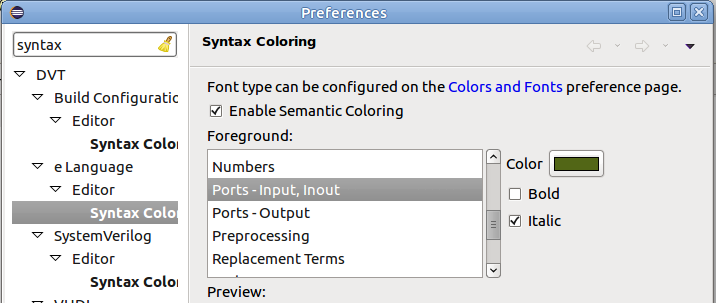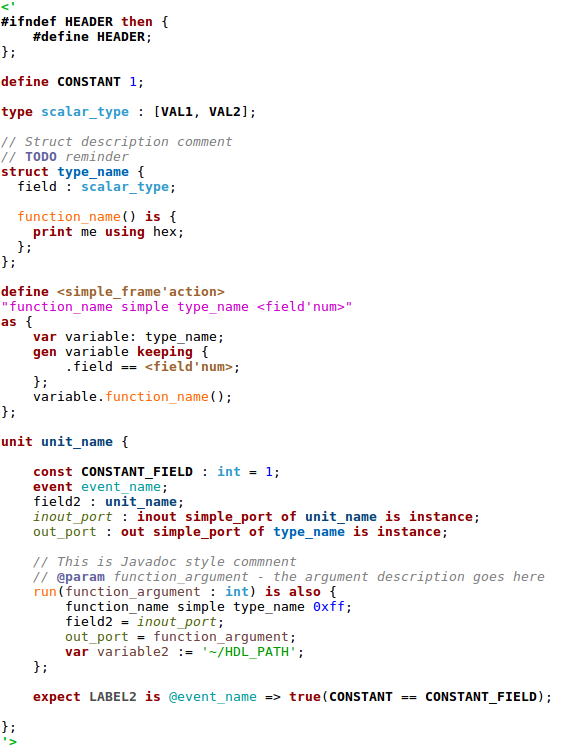DVT e Language IDE User Guide
Rev. 24.1.9, 26 April 2024
- Installation Checklist
- Predefined Projects
- Getting Started
- What is a Workspace
- What is a Project
- Project Natures
- Workspace and Workbench
- Refresh
- Linked Resources
- Backup and Local History
- Basic Tutorial
- Switch to the DVT Perspective
- Open a Project
- Configure the Build
- Build the Project
- Inspect the Compilation Errors
- See Comments in Tooltips
- Use Hyperlinks to Move Around in the Code
- Quickly Open a Type (Struct, Unit)
- Quickly Open a File
- Quickly Move Inside the Editor
- Browse Through All the Available Types (Structs, Units, Enumerations)
- Browse the AOP Extensions
- Inspect the Struct Hierarchy and Struct Members
- Inspect the Verification Hierarchy
- Search for Entities
- Use Content Assist (Autocomplete)
- Use Code Templates
- Track Tasks using TODO Markers
- Format the Source Code
- Quickly See the Current Scope in the Status Bar
- Locate the Matching Bracket
- Fold Code Regions in Order to Improve Readability
- Load in Specman
- Build Configurations
- Non-top files
- default.build
- Auto-config
- Simulator Log-config
- Emulating compiler invocations
- Multiple .build Files
- Compatibility Modes
- Paths
- Strings
- Comments
- Environment Variables
- Including Other Argument Files
- Build Persistence
- DVT Auto-Linked
- Run a Script Before Build
- All Build Directives
- e Language Test Files
- e Language SPECMAN_PATH
- SystemVerilog OVM or UVM Library Compilation
- Xilinx Libraries Compilation
- Intel(Altera) Quartus Libraries Compilation
- Questa Libraries Compilation
- Use of External Programs
- Breadcrumb Navigation Bar
- Compile Checks
- Content Assist (Autocomplete)
- Quick Fix Proposals
- Quick Assist Proposals
- Content Filters
- Code Templates
- File Templates
- Project Templates
- Code Formatting
- Inspect Extensions (Layers)
- Override Methods
- Extend Annotation
- Semantic Search
- Search for References (Usages, Readers or Writers)
- Show Instances
- Show Constraints
- Show Emitters
- Quick Search in Views
- Refactoring
- Diagrams
- Export HTML Documentation
- External Tools Integration
- Debugger Integration
- Custom Dialogs
- Command Line Interface
- dvt_cli.sh
- Syntax
- Examples
- Makefile Example
- Commands
- Create a Project (Mixed-Language Capable)
- Create a Project From an Existing Template
- Import an Existing Project
- List Compiled Files
- Compare Files
- Launch a Run Configuration
- Open a File
- Close a File
- Open a Custom Dialog
- Open a Perspective
- Refresh a Project
- Rebuild a Project
- Print Edited File
- Quit
- Query the running status
- Print version
- Run Performance Exploration
- Macros Support
- Reminders (TODO Markers)
- UVM Support
- Settings Management
- > Reference
- Comments Formatting
- Common Shortcuts
- Custom Pragmas
- DVT Resource Monitor
- Editor Right Click Menu
- Hyperlinks
- Icons and Decorations
- Lazy Bring up Resources
- Memory Monitor
- Scripts
- > Syntax Coloring
- Themes
- Tooltips
- Toolbar Actions
- Views
- Application Notes
- Tips and Tricks
- Q & A
- I am new to Eclipse, where should I start from?
- Where can I find DVT Help?
- How do I see and configure the key shortcuts?
- Are there any backup files in Eclipse?
- Workspace in use, cannot launch eclipse...
- Locking is not possible in the directory...
- How to start DVT Eclipse with a different eclipse.ini
- Save could not be completed
- IBM Clearcase Plugin
- How do I Access Files Outside Project Dir - Working with Linked Resources
- Handling UNRECOGNIZED Macros
- Mapping Linux to Windows (/proj/ to Z:\proj\)
- How to use Working Sets for filtering Problems/Task/Search views?
- Whitespace in macro definition
- Subversive vs Subclipse
- How do I associate a project with both DVT and CDT?
- Can I use vi/vim along with DVT?
- Can I perform dos2unix or unix2dos from DVT?
- How can I configure Eclipse to use a local CVS repository?
- I am using the Common Desktop Environment via Citrix and experiencing crashes. What can I do?
- How do I change the background color of the Editor?
- Some widget colors are not displayed properly. What can I do?
- How do I change the tooltip colors?
- How do I change Internet Proxy Settings?
- Eclipse does not start, there is no Workspace, metadata or log file created
- Workspace permissions
- How do I link mylyn with Bugzilla?
- How do I print source code?
- How do I disable Eclipse Software Sites?
- How do I revert to a previous version?
- What are the most common shortcuts in DVT?
- How do I run Specman using IntelliGen?
- How does DVT integrate with emacs?
- How does DVT integrate with CVS?
- How to set an environment variable within a Run Configuration?
- How to run a remote Unix command from DVT Eclipse for Windows?
- How do I tell DVT to skip some files from compilation?
- Rebuild shortcut (Ctrl + Alt + R) does not work
- I want to use an alias in a DVT Generic Run Configuration, but it's not recognized
- Some files are missing from the VIPs transformed with evip2dvt.sh
- How to set multiple paths as sources of predefined projects ?
- Lines are suddenly changing indentation when I edit text or move the cursor through the editor.
- How to change the directory where the build log file is saved ?
- How to find the DVT logs on Linux/Unix ?
- How to create resource filters ?
- How to create custom shortcut and button for a Run Configuration?
- I know that file.foo is present in the project location, but I can't see it in the Navigator View
- How to copy the full path to the file in the current editor?
- How to adjust the console logs filters matching parameters?
- When I switch to Block (Column) Selection mode the font changes
- In Block (Column) Selection mode I see strange editng artifacts
- How to modify the font size in the code editors?
- How to automatically checkout/lock files from the revision control system ?
- How can I see if a file is read-only?
- How can I open a file in DVT from the terminal?
- How can I open a file in DVT from Questa?
- How do I change the name of the xterm opened by a DVT Generic Run Configuration?
- I get errors while installing or updating a plugin from an update site
- What is New?
- How to Report an Issue?
- Legal Notices
- Third Party Licenses
Source code is colored in the DVT editor. Some language constructs are colored based on a syntactical analysis of the code, while others require a more elaborate semantic analysis, as detailed in the table below. Semantic coloring is only performed when the source code is compiled.
| Category | Requires compilation | Details |
| Arguments | y | Function arguments |
| Comment Hyperlinks | ||
| Comment Pragmas | y | Compilation is required for Custom Pragmas |
| Comments | ||
| Constants | y | Const fields, enum members and predefined constants like TRUE, FALSE |
| Default | Any word which does not belong to other categories | |
| Define Groups | Syntactical category tag of a define as or define as computed macro | |
| Events | y | |
| Expansion Literals | ||
| Expansion Replacements | ||
| Fields | y | Struct fields and union fields |
| HDL Paths | ||
| Javadoc Tags | ||
| Keyphrases | Combination of keywords: "is a", "keep for each" | |
| Keywords | ||
| Labels | y | |
| Methods | y | Methods and time consuming methods |
| Numbers | ||
| Ports - Input, Inout | y | |
| Ports - Output | y | |
| Preprocessing | Preprocessing #macros | |
| Replacement Terms | Constructs like <any>, <exp>, <type> | |
| Section Start/End | Begin or end of code section <' and '> | |
| String Literals | ||
| Task Tags | ||
| Types | y | scalar types, units, structs |
| Template Identifiers | ||
| Time Units | Time units like ms, ns or ps | |
| Variables | y |
You can change the coloring style for each of the categories. Go to Window > Preferences > DVT > e Language > Editor > Syntax Coloring, select the category you wish to modify from the list and set the color and font style.

A code sample in the Syntax Coloring preference page helps you preview the changes instantly. The default style is shown below:

Note: Inside macro definitions and macro calls, only syntactic coloring is performed.